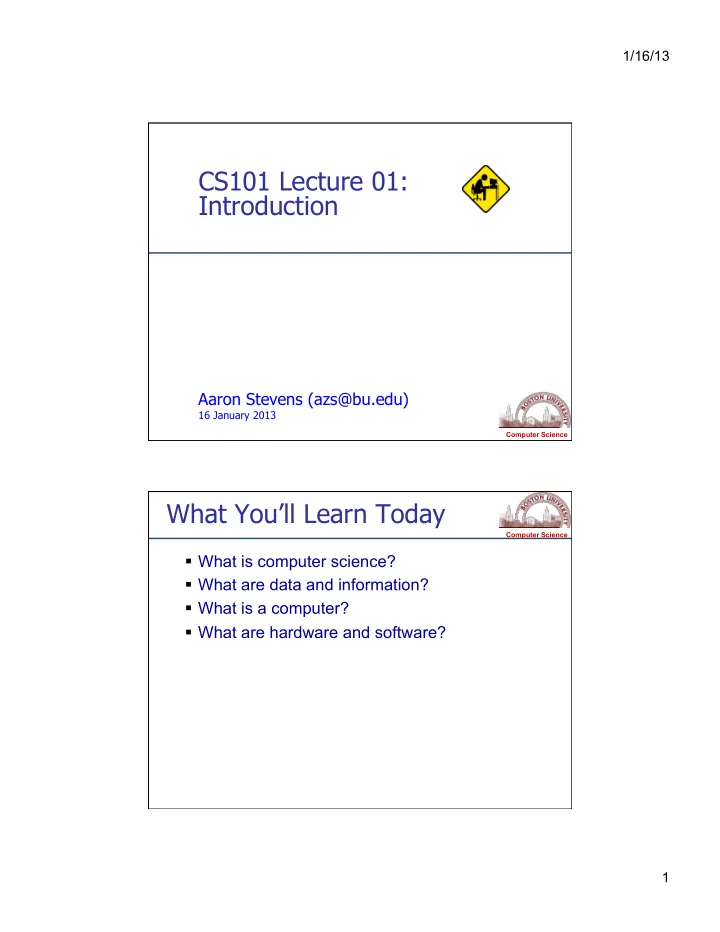

1/16/13 CS101 Lecture 01: Introduction Aaron Stevens (azs@bu.edu) 16 January 2013 Computer Science What You’ll Learn Today Computer Science What is computer science? What are data and information? What is a computer? What are hardware and software? 1
1/16/13 What is Computer Science? Computer Science CS is NOT Science! Computer Science The fundamental ideas of CS are: Encoding Information Algorithms Protocols Abstraction 2
1/16/13 Flashlight Messaging Computer Science Imagine you are 10 years old, in 1980... Your best friend lives next door. You want to send messages at night. You each have a flashlight. What do you do? Easy as ABC, 123 Computer Science 13 5 5 20 13 5 1 20 19 20 1 18 2 21 3 11 19 3
1/16/13 Numbered Code Computer Science Replace each character with a number… Coded Message Example: 13 5 5 20 13 5 1 20 19 20 1 18 2 21 3 11 19 Encoding is about converting data into a coded form. Decoding is about converting from coded to normal form. Algorithm Computer Science An algorithm is a sequence of clear and precise step-by-step instructions for solving a problem in a finite amount of time. 4
1/16/13 Encoding Algorithm Computer Science while more characters in message: c = next character in message n = number corresponding to that letter send n flashes pause done: no more flashes Decoding Algorithm Computer Science while observing more flashes: n = count number of flashes until pause c = character corresponding to n flashes write down character c done 5
1/16/13 Numbered Code: Good Enough? Computer Science What ’ s good about the numbered code? What ’ s not so good about it? Protocols Computer Science A protocol is a set of rules governing the exchange or transmission of data between devices. 6
1/16/13 Example Protocol: Morse Code Computer Science Invented by Samuel Morse for the telegraph in 1840s: A dash is equal to three dots 1. The space between parts of the 2. same letter is equal to one dot The space between two letters is 3. equal to three dots The space between words is 4. equal to seven dots Example of telegraph key/sounder and Morse code: http://www.youtube.com/watch?v=Lki3jxNLVCI Encoding Example: Braille Computer Science Each character is up to 6 dots. Each dot is either on or off. Invented by Louis Braille (1809-1852). 7
1/16/13 What are we looking at? Computer Science No, this is the matrix! Computer Science 8
1/16/13 What is this? Computer Science Computer Science Your web browser interprets the coded data (1s and 0s) and renders the Facebook webpage. 9
1/16/13 Abstraction Computer Science Abstraction is about hiding unnecessary details and retaining only the relevant information. Data and Information Computer Science Data is a fact pattern: Information is how we interpret that pattern: 10
1/16/13 What is a Computer? Computer Science What is a computer, anyway? A computer takes an input, applies a process, and produces an output. Give some examples: 2 What is a Computer? Computer Science 11
1/16/13 Hardware Computer Science 3 Software Computer Science 3 12
1/16/13 What You Learned Today Computer Science Computer Science is NOT a Science Algorithms, Encoding Information, Protocols, and Abstraction. Data vs. Information Computers Hardware/Software Setting up a CS account Computer Science 13
1/16/13 Announcements & To Do Computer Science Lab 1: Sign up for lab account Go during your scheduled lab meeting time on Thursday. Create your CS account and try out websubmit. Readings: Reed chapter 1 (today) Reed ch 4, pp 63-79 (Friday) Analog and Digital Computer Science Analog Computers Information is processed directly in its indigenous form. Digital Computers Information processing and storage occurs using a symbolic representation of the data. 3 14
1/16/13 Example: Analog Computer Computer Science The slide rule is a mechanical calculator. It works by aligning two logarithmic scales. Align the inputs, and read off the output. Digital Computers Computer Science Symbolic Representation Using a limited set of symbols to represent any original text/information. Digital computers process and store information as a discrete pattern of electrical charges. 3 15
Recommend
More recommend